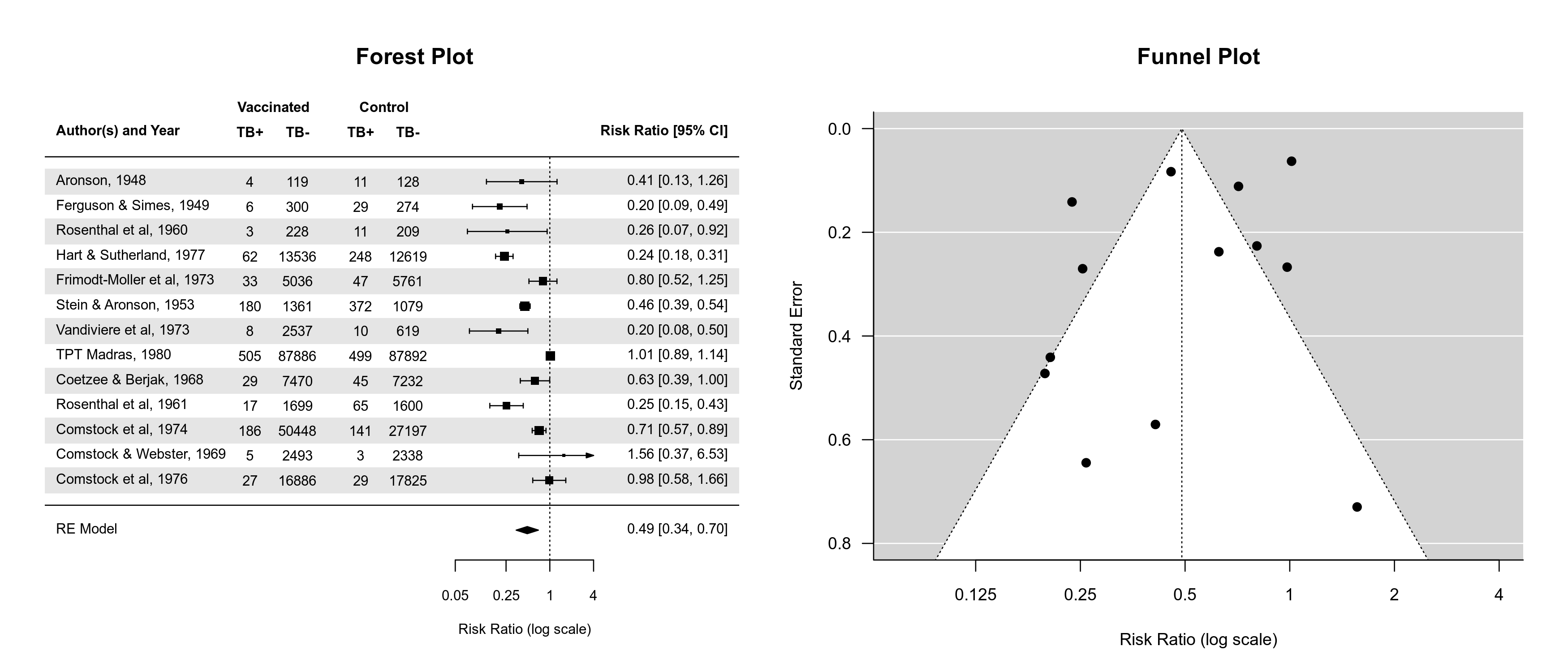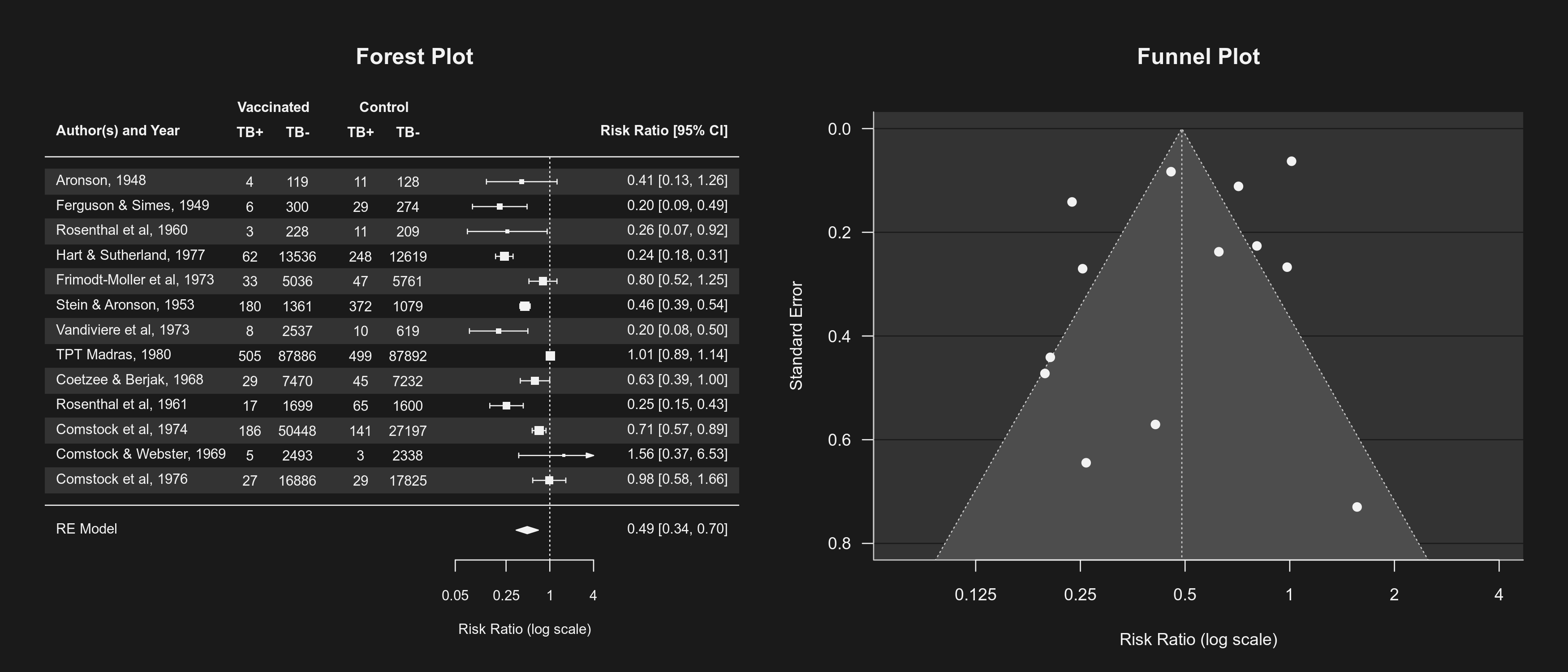Package News for 2023
2023-09-27: Version 4.4-0 Released on CRAN
A new version of the metafor package has been released on CRAN. Some of the more important/interesting updates to the package include:
- The older (convoluted) way of setting some package options has been replaced by two functions,
getmfopt()andsetmfopt(), for getting and setting package options. This new approach makes use of the standard way of setting options in R (seehelp(options)). Also, some of the options that can be set in this way are now more flexible. - The
fsn()function can now carry out a fail-safe N calculation based on a random-effects model (when usingtype="General"). This is a generalization of the Orwin and Rosenberg methods, which is an interesting methodological development in itself. - The theming of all plots (based on the foreground and background colors of the plotting device) has been further improved. Within RStudio, plot colors can now also be automatically set based on the theme (with
setmfopt(theme="auto")). - The various
forest()functions now have an additional argument calledtabfig, which makes it easier to exactly align the numbers in the annotations on the right-hand side. - The
addpoly.default()andaddpoly.rma.predict()functions gain aconstareaargument, for the option to draw the polygons with a constant area. This idea arose from a discussion on Mastodon about drawing so-called 'diamond plots' (see https://psyarxiv.com/fzh6c for more details about such plots). The idea is that, by default, the eyes of the person looking at a plot are automatically drawn to the polygons that have a wider confidence interval (which occupy a larger area on the plot), which is actually the opposite of what you want to happen (since estimates with wider confidence intervals are less precise). By making the area of the polygons constant (which requires reducing their height according to the interval widths), this undesired effect can be compensated to some extent. - Two new measures have been added to
escalc(), namely"R2"and "ZR2", for meta-analyzing coefficients of determination (but read the caveats mentioned underhelp(escalc)with respect to these measures). - For measures
"PCOR","ZPCOR","SPCOR", and"ZSPCOR", argumentmiinescalc()now refers to the total number of predictors in the regression models (i.e., also counting the focal predictor of interest). This is a non-backwards compatible change (which I really try to avoid), but in this case this was important for consistency with other measures/equations. The change is also very minor, sincemialways appears in equations as a value that is subtracted fromni(the sample size) and since the latter is (hopefully) large relative tomi, the impact of this change should be very minor. - The suite of automated package tests now also includes automated visual comparison tests of plots. Therefore, any changes I make to the package that unintentionally break a particular plotting function are now automatically detected.
The full changelog can be found here.
2023-08-13: Dynamic Plot Colors Based on the RStudio Theme
I am quite excited about a new feature that will be part of the upcoming version of the metafor package. The package now creates all plots in such a way that (if one sets setmfopt(theme="auto")) they will have a consistent look depending on the chosen RStudio theme. You can see below some examples of how various plots change their look according to the theme:
This creates a more pleasing experience when working interactively with RStudio, but could also be useful when creating presentations that do not use a white background.
The default setting (setmfopt(theme="default")) uses the default colors of the plotting device (which is typically a white background and a black foreground color), but one can also use setmfopt(theme="dark") to force plots to be drawn using a 'dark mode' (this may be useful when working with a different programming editor or IDE that also uses a dark mode).
2023-05-08: Version 4.2-0 Released on CRAN
I made a relatively quick release of another version of the package. There were a few minor little buglets that annoyed me that I wanted to get rid of right away. Along the way, I made some improvements to various plotting functions. In particular, the various forest() functions now do a better job of choosing default values for the xlim argument and the ilab.xpos argument values are now also automatically chosen when not specified (although it is still recommended to adjust the default values to tweak the look of each forest plot into perfection). There is now also a shade argument for shading particular rows of the plot (e.g., for a 'zebra-like' look).
Also, the various plotting functions now respect par("fg"). This makes it possible to easily create plots with a dark background and light plotting colors. By default, plots created in R have a light (white) background and use dark colors, like this:

But if we set up the plotting device like this:
bg <- "gray10" fg <- "gray95" dev.new(canvas=bg) par(fg=fg, bg=bg, col=fg, col.axis=fg, col.lab=fg, col.main=fg, col.sub=fg)
then the resulting plots look like this:

So in case you prefer a dark mode for your IDE/editor, opening a plot in this manner no longer feels like starring directly into the sun.

Such an awesome movie, by the way.
Finally, aside from a few other improvements (e.g., functions that issue a warning when omitting studies due to NAs now indicate how many were omitted), the rma.glmm() function (when measure="OR", model="CM.EL", method="ML") now treats $\tau^2$ values below 1e-04 effectively as zero before computing the standard errors of the fixed effects. This helps to avoid numerical problems in approximating the Hessian. Similarly, selmodel() now treats $\tau^2$ values below 1e-04 or min(vi/10) effectively as zero before computing the standard errors.
The full changelog can be found here.
2023-03-19: Version 4.0-0 Released on CRAN
I am excited to announce the official (i.e., CRAN) release of version 4.0-0 of the metafor package. This will be the 30th update to the package after its initial release in 2009. Since then, the package has grown from a measly 4460 lines of code / 60 functions / 76 pages of documentation to a respectable 36879 lines of code / 330 functions / 347 pages of documentation. Aside from a few improvements related to modeling (e.g., the emmprep() function provides easier interoperability with the emmeans package and the selmodel() function gains a few additional selection models), I would say the focus of this update was on steps that occur prior to modeling, namely the calculation of the chosen effect size measure (or outcome measure as I prefer to call it) and the construction of the dataset in general.
In particular, the escalc() function now allows the user to also input appropriate test statistics and/or p-values for a number of measures where these can be directly transformed into the corresponding values of the measure. For example, the t-statistic from an independent samples t-test can be easily transformed into a standardized mean difference or the t-statistic from a standard test of a correlation coefficient can be easily transformed into the correlation coefficient or its r-to-z transformed version. Speaking of the latter, essentially all correlation-type measures can now be transformed using the r-to-z transformation, although it should be noted that this is not a proper variance-stabilizing transformation for all measures. This can still be useful though since the r-to-z transformation also has normalizing properties and when combining different types of correlation coefficients in the same analysis (e.g., Pearson product-moment correlations and tetrachoric/biserial correlations).
Finally, there are now several functions in the package that facilitate the construction of the dataset for a meta-analysis more generally. The conv.2x2() function helps to reconstruct 2x2 tables based on various pieces of information (e.g., odds ratios, chi-square statistics), while the conv.fivenum() function provides various methods for computing (or more precisely, estimating) means and standard deviations based on five-number summary values (i.e., the minimum, first quartile, median, third quartile, and maximum) and subsets thereof. The conv.wald() function converts Wald-type tests and/or confidence intervals to effect sizes and corresponding sampling variances (e.g., to transform a reported odds ratio and its confidence interval to the corresponding log odds ratio and sampling variance). And the conv.delta() function transforms effect sizes or outcomes and their sampling variances using the delta method, which can be useful in several data preparations steps. See the documentation of these functions for further details and examples.
If you come across any issues/bugs, please report them here. However, for questions or discussions about these functions (or really anything related to the metafor package or meta-analysis with R in general), please use the R-sig-meta-analysis mailing list.